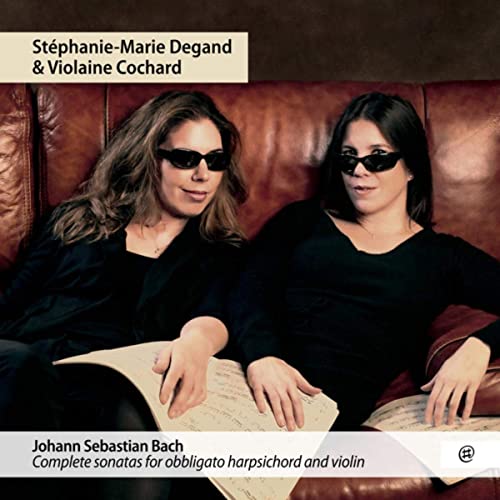Stéphanie-Marie Degand violin and Violaine Cochard harpsichord
91:00 (2 CDs in a card folder)
NoMadMusic NNM 071
Click HERE to buy this recording digitally on amazon.co.uk
This recording of the six ‘sonatas for obbligato harpsichord and violin’, as the duo reminds us in the brief liner notes that all the copies of these six sonatas that date from Bach day are titled, is the fruit of many years friendship and musical collaboration since the pair were students in the 1990s. The violinist is a protégé of Emanuelle Haïm, and co-founder of Le Concert d’Astrée, but also plays a wide range of more modern music. The harpsichordist is also a singer, and both their biographies in the liner notes are gushingly superlative. In spite of this, I was not altogether taken with their playing of these Bach sonatas.
They tell us how important it is to hear the right hand of the harpsichord part equally balanced with the violin, yet in the recording, the violin is overwhelmingly projected above the harpsichord, and played for my taste with an almost Brahmsian lushness. Either the engineers hadn’t taken the equality of the harpsichord seriously, choosing to regard it as simply the accompaniment of a solo, or the microphones were placed much too close to the violin. Either way, the performers should have corrected this and re-balanced the recording, as especially in the quicker movements with a lot of canonic writing like the first Allegro in the C minor sonata (CD 2.2) or of the F minor sonata (CD 2.6), the harpsichord is not just an unequal partner, it is barely audible at times.
As I grew increasingly dissatisfied, I turned again to my favourite recording of these sonatas made in 2000 by Trevor Pinnock and a youthful Rachel Podger, which is streets ahead of this one, both in balance and clarity of the part-writing and also in the musical understanding of Bach’s interweaving lines. Just compare the first two movements in the F minor sonata in the two recordings and feel the flow and direction in the long phrases from Podger and Pinnock (CD 2.9/10) through the wonderful key-changes in the first movement, where Degand and Cochard (CD 2.5/6) seem to lose their rather self-indulgent way. You really have to know where you are going when playing Bach if you are to take your listeners along with you.
The violin is by Joseph Catenari, 1710 and played with a Tourte bow; the harpsichord is by Ryo Yoshida, after a German one by Gottfried Silbermann. There is no information about temperament or tuning, nor anything about Bach’s music. For that, you need to go to Podger and Pinnock (CCS 14798) and the essay by Jonathan Freeman-Attwood.
All in all, I am sorry to say that I cannot find much to like in this version.
David Stancliffe
